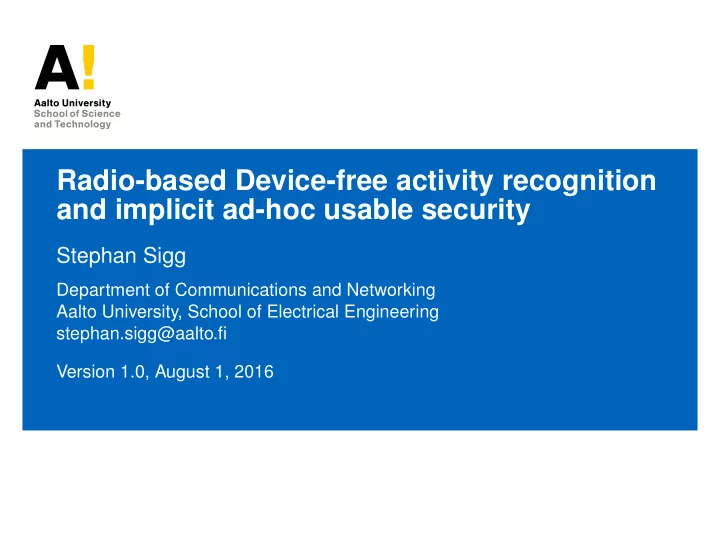

Radio-based Device-free activity recognition and implicit ad-hoc usable security Stephan Sigg Department of Communications and Networking Aalto University, School of Electrical Engineering stephan.sigg@aalto.fi Version 1.0, August 1, 2016
Stephan Sigg August 1, 2016 2 / 19
Secure authentication from an Egocentric Camera Stephan Sigg August 1, 2016 3 / 19
Secure authentication from Egocentric camera Stephan Sigg August 1, 2016 4 / 19
Try and break it: http://ambientintelligence.aalto.fi/passframe/ Stephan Sigg August 1, 2016 5 / 19
Frame selection and challenge generation Stephan Sigg August 1, 2016 6 / 19
Key Frames Processing Time Tablet-class (AMD E2-1800 1.7GHz) 118 51 sec Desktop (Intel Core I5-2400 3.1GHz) 118 9 sec Segmentation clustering Stephan Sigg August 1, 2016 7 / 19
Stephan Sigg August 1, 2016 8 / 19
RF-based device-free activity recognition Stephan Sigg August 1, 2016 9 / 19
RF-based device-free activity recognition g n g Crawling n i i d k n a l t a S W empty L y i n g Stephan Sigg August 1, 2016 10 / 19
Modelling CSI vectors via multivariate Gaussian We model the amplitude of every CSI reading at location ’y’ to approximately follow a multivariate Gaussian Distribution. Location is then predicted via the maximum likelihood estimate. Stephan Sigg August 1, 2016 11 / 19
Situation and gestures from passive RSSI-DFAR 10cm 10cm Towards Away Hold over Open/close Take up Swipe Swipe Swipe Swipe Wipe No right bottom top left gesture Stephan Sigg August 1, 2016 12 / 19
Situation and gestures from passive RSSI-DFAR 10cm 10cm Towards Away Hold over Open/close Take up Swipe Swipe Swipe Swipe Wipe No right bottom top left gesture Stephan Sigg August 1, 2016 12 / 19
Gesture recognition from RF Stephan Sigg August 1, 2016 13 / 19
Stephan Sigg August 1, 2016 14 / 19
Calculation during transmission on the channel Motivation: Computation during transmission a ◮ Max. rate to compute & communicate functions ◮ Mention: Collisions might contain information a Giridhar et al, Toward a theory of in-network computation in wireless sensor networks, IEEE Comm. Mag., vol. 44, no 4, pp. 98-107, april 2006 Calculation of by means of post- and pre-processing a ◮ Requires accurate channel state information ◮ Requires identical absolute transmit power a M. Goldenbaum, S. Stanczak, and M. Kaliszan, On function computation via wireless sensor multiple-access channels, IEEE Wireless Communications and Networking Conf., 2009 Stephan Sigg August 1, 2016 15 / 19
Calculation during transmission on the channel Utilising Poisson-distributed burst-sequences transmit burst sequences . . . . . . . . . . . . . . . . . . . . . . . . . . . burst . . . . . . . . . . . . . . . . . . time superimposed received burst sequence . . . . . . . . . . . . t K ◮ Addition, subtraction, division and multiplication at the time of wireless data transmission via Poisson-distributed burst-sequences ◮ Adding Poisson processes i with mean µ i will result in a Poisson process with mean � n i = 1 µ i . Stephan Sigg August 1, 2016 16 / 19
Calculation during transmission on the channel Case study to compare the calculation accuracy ◮ Utilise data from the Intel Berkeley laboratory network (here: temperature) 1 ◮ Transmission of data by simple sensor nodes 1http://db.csail.mit.edu/labdata/labdata.html Stephan Sigg August 1, 2016 17 / 19
Calculation during transmission on the channel Online Online Offline Offline Stephan Sigg August 1, 2016 18 / 19
Thank you! Stephan Sigg stephan.sigg@aalto.fi Stephan Sigg August 1, 2016 19 / 19
Recommend
More recommend